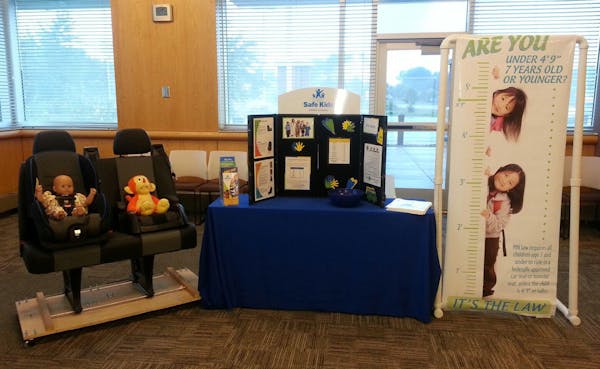As a new parent, Missi Reeder wasn't confident about how to install the car seat for her baby. Reading the instructions didn't help, either.
"I would think I 'get' it and then I would second-guess myself," she said.
So she sought help from a trained professional at her local fire station. Sure enough, she had things wrong. That was a decade ago. Now, a mother of three and a safety and education coordinator in the Anoka County Sheriff's Office, Reeder is educating other parents and caregivers on the subject.
She has seen that many others struggle with the same things she did, and that the vast majority of car seats are installed improperly.
That's why Safe Kids Anoka County, an organization she's involved with, hosts free car seat clinics throughout the year. Several are planned for the coming months in various locations. Safe Kids Anoka County also leads bike helmet clinics and child safety camps.
Residents also can set up private one-on-one inspections year-round, Reeder said, and other cities hold similar clinics, as well (visit www.buckleupkids.mn.gov to find one near you).
During the checks, technicians cover everything from choosing the right car seat to making sure it's snugly in place inside the vehicle. They also field any questions people might have. The sessions take about 30 to 45 minutes and they're "super effective," Reeder said.
Reeder encourages anyone who has "even the slightest inkling that they have it wrong, to get it checked," she said, noting that a simple adjustment can make a big difference in a crash. On the flip side, "something small could be something big if people don't make the effort," she said.
Chilling statistics
"Motor vehicle crashes are the leading cause of accidental death for children" ages 4 to 16, in the country, according to Laura Landes, a crime prevention specialist in the Anoka County Sheriff's Office.
In Minnesota, between 2009 and 2013, 10 children ranging in age from 4 to 7 were killed in car accidents, according to Heather Darby of the Minnesota Department of Public Safety. Only three of the children were restrained properly, she said.
Landes, like Reeder, says people often don't realize that "the most minor infraction can make a difference on how a child weathers a crash."
By state law, children 8 and under need to ride in a federally approved car seat or booster seat or until they're over 4 feet 9 inches tall. It's safest to keep a child in a car seat as opposed to a seat belt only until they reach that height.
Technicians often talk about keeping children in car seats that face backward until the kids turn 2 years old and weigh 20 pounds or more. "It's so much easier on the spinal cord when they're in a crash. The strain isn't as bad," Landes said.
This is relatively new information, given that state law only requires that children be rear facing until they're 1 year old. However, pediatricians say that a child needs 2 years to develop the strength to withstand a crash, Landes said.
At the clinics, car seats are available for sale or free to those who qualify based on income, Landes said. The group steers people away from used car seats, as they have a "life expectancy" of about five years, depending on the manufacturer, the Safe Kids Anoka County website states.
"This work is so grass roots and important. It has to be done in the community," Landes said. "You can't just send out a brochure. You have to spend the time and make the effort to engage residents."
Some people come to the clinics for validation. "We focus on giving parents the tools they need so they can do it in their car or a grandparent's car, or whomever's," she said, adding that more and more grandparents are attending the clinics. "A lot has changed since they transported their children 30 years ago."
Making strides
Darby, from the traffic safety office of the Minnesota Department of Public Safety, said that clinics like those in Anoka County are happening statewide every week.
She stressed the importance of choosing the right seat for a child.
When it comes to booster seats, things are improving, she said, citing a 2014 survey conducted by law enforcement agencies across the state. It showed that 72 percent of children were correctly secured in booster seats, compared with 64 percent in 2011, "so we continue to make those strides," Darby said.
"Children should progress through different restraints as they grow up, starting with rear-facing infant seats and moving into forward-facing toddler seats, booster seats and finally, seat belts," a prepared statement from the state department reads.
Additionally, it's important for parents to buckle up, too, not only because it's the law, but also to be a good role model for their children, she said.
Anna Pratt is a Minneapolis freelance writer. She can be reached at annaprattjournalist@gmail.com.

Minnesota Sports Hall of Fame: A class-by-class list of all members

This retired journalist changed professional wrestling from Mankato

